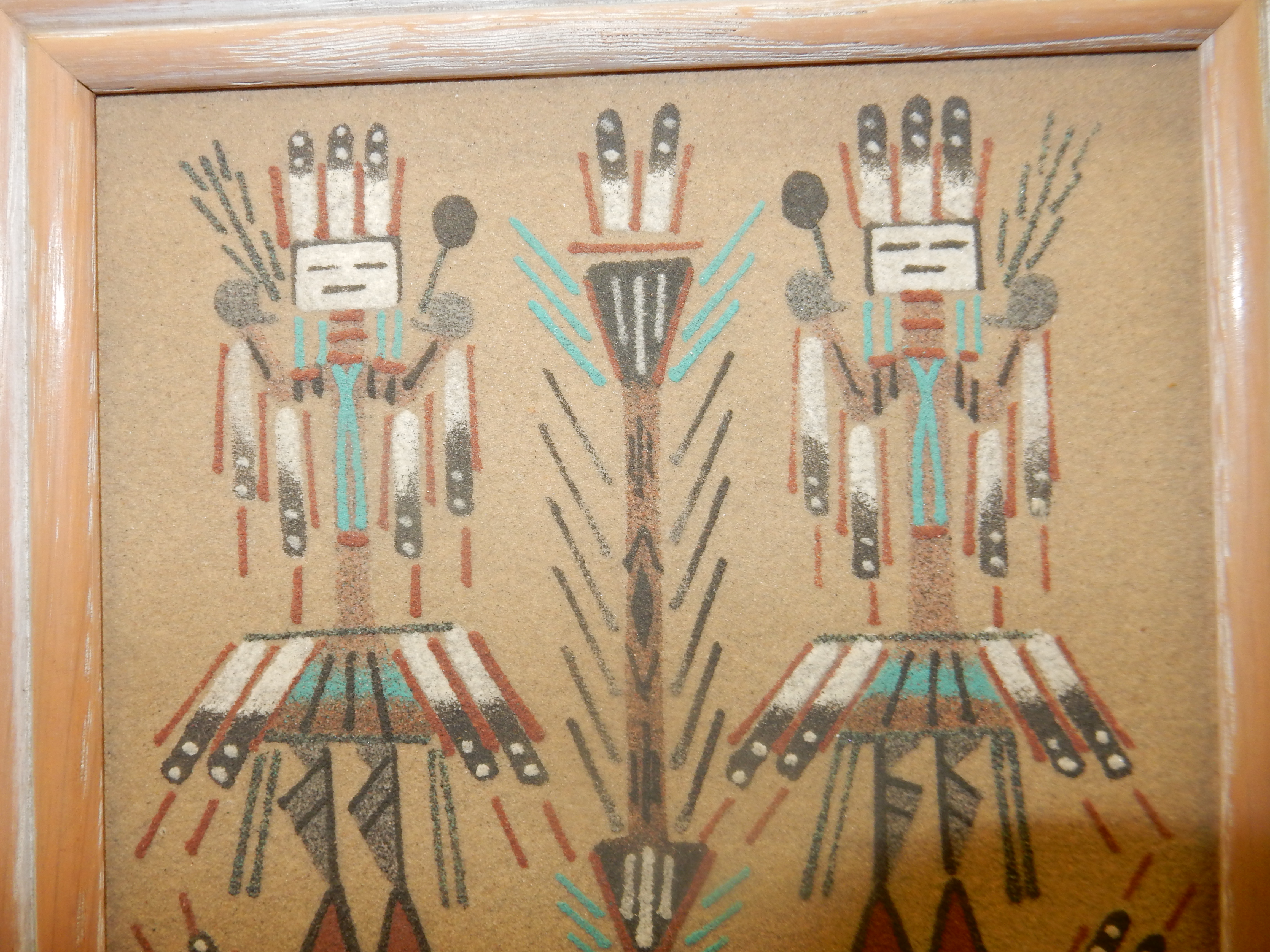A famous Navajo artist Glen Nez uses naturally occurring colored rock that are crushed into sand for each of his sand paintings. This sand painting is artistically triple matted in a dark walnut wood frame.

Navajo Sand Painting Native American Trading Co
The Navajo Sand Painting is a symbolic representation of some portion of Navajo mythology and is a big part of the lengthy curing rites and is used by most tribes in the Southwest.
. The Diné is the Navajo name for themselves and the term they use for sand painting is iikááh which means a place where the gods come and go. It is a sacred practice. Sand paint ing ˈsand-ˌpān-tiŋ Definition of sandpainting.
Navajo Sand is a paint color from our Neutrals paint colors family. Sandpainting is the art of pouring coloured sands and powdered pigments from minerals or crystals or pigments from other natural or synthetic sources onto a surface to make a fixed or unfixed sand painting. Each color symbolizes a time of day and direction.
The Navajo word to indicate the sand paintings is iikaah which means the place where the holy people comes and goes because during the ceremonies There are powerful supernatural forces and only the shaman knows how long it will take to heal what herbs to use. They are created to aid in the restoration of health and harmony hózh in the life of the patient the one sung over. The Navajo name for sandpainting iikaah translates to place where gods come and go This name is appropriate because if all activities are performed correctly and the patient believes in the cure the sandpainting prepares the way for the forces or Holy People to intercede and restore hozho.
The buffalo horns are a symbol of strength the eagle feathers at their tips represent balance and justice and the bars on each side represent the rainbow. A medicine man is consulted as to what ceremony is required and often uses divination to decide the matter. This is referred to by the Navajo as an iikaah a place where the gods come and go The sandpainting is the crucial element in this 2- to-9-day ceremony which is designed to restore balance hozho thus restoring lost health or insuring good things The Singer uses crushed stone crushed flowers gypsum pollen etc.
Navajo Sun Sand Painting. Check out our painting advice guides for more tips on picking the right paint color for your next painting project. Sandpaintings or better drypaintings iikááh are an essential part of Navajo ceremonials Diné binahagha and as such are sacred.
Within the Navajo culture there are several symbols that have specific meanings when displayed. Double-matted with solid oak. While the only significant venomous snakes present are the rattlesnakes all snakes are avoided.
The sandpainting has been used for centuries in religious rituals including. For good reason one Navajo term forsandpaintings means place where the gods come and go Once those Holy People-First Man and First Woman First Girl and First Boy Corn People Snake People and others-livedunderground. The Navajo word for sandpaintings means place where the gods come and go.
The Navajo Indians have developed the sand painting art to the greatest degree and have between 600 and 1000 separate sand painting designs. Most art authorities concede that the Southwestern sand paintings produced by the Navajo are the intricate complex and beautiful art-forms. Also known as dry paintings sandpaintings meant places where gods come and go in the native Navajo language.
For theDínehor People as Navajos call themselves sandpainting is a sacred healing art linked tothe time of myth and memory. Navajo sand paintings are used to spiritually cure a patient of an illness. Navajo Symbolism and Sand Painting rites November 7 2009 by Harold Carey Jr ALL ceremonies are for healing either of fears or of bodily ailments and each is a communal affair paid for by the patients relatives.
Snakes are seen in Navajo sand paintings and other artworks. The Navajo Sandpainting WeavingPreserves Tradition and Ceremony. The original Navajo dry painting is traditionally performed for religious or medicinal purposes.
The snake is also a symbol of the lightning people and brings rain to the dry land. Navajo sandpaintings even though one of the most popular forms of Navajo art were not created to be art but rather a part of a sacred healing ritual or ceremony performed by medicine men. 14 X 14 Shipping is free.
Unfixed sand paintings have a long established cultural history in numerous social groupings around the globe and are often temporary ritual paintings. A ceremonial design as of the Navajo Indians made usually of colored sands on a flat surface also. The Navajo Sandpainting Weaving is ranked among the Navajo tribes best known and best loved art forms.
Most of the native languages do not have a word to indicate the traditional medicine that it is called mystery. The Navajo Sand Painting is a symbolic representation of some portion of Navajo mythology and is a big part of the lengthy curing rites sand paintings are used by most tribes in the Southwest. Sandpaintings are used in ceremonies designed to.
Navajo-crafted traditional Sand Painting featuring the life-giving Sun. The Navajo Indians have developed them to the greatest degree. You might find these symbols in their sandpaintings their general artwork and even in their current government structures.
The painting itself allows a portal to be opened and connection to be made between the Holy People the Medicine Man and the patient.

A History Of Graphic Design Chapter 78 Navajo Indians Sand Painting

Meaning Of Indian Symbols Sand Paintings

A History Of Graphic Design Chapter 78 Navajo Indians Sand Painting

Native American Sand Paintings


0 komentar
Posting Komentar